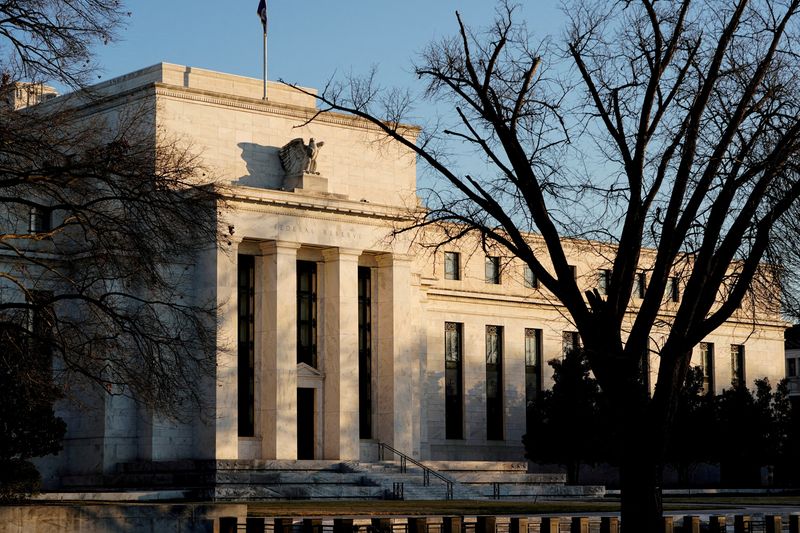(Reuters) - Since 1994 when the Federal Reserve first began issuing a statement announcing actions taken at each monetary policy meeting, it has initiated new interest-rate cutting cycles or has returned to rate cuts after a prolonged pause in rate changes on about 10 occasions.
Following is a list of those pivotal moments along with the key phrases from each policy statement:
July 1995: With inflation contained, the Fed lowered the fed funds rate to 5.75% from 6.0%, where it had been since February 1995.
"As a result of the monetary tightening initiated in early 1994, inflationary pressures have receded enough to accommodate a modest adjustment in monetary conditions."
December 1995: Confident still that inflation was subdued after five months with the funds rate at 5.75%, the Fed lowered it by 25 basis points and would do so again at its next meeting in January.
"Since the last easing of monetary policy in July, inflation has been somewhat more favorable than anticipated, and this result along with an associated moderation in inflation expectations warrants a modest easing in monetary conditions."
September 1998: After a year-and-a-half with the funds rate at 5.50%, the Fed in a risk-management move lowered it by 25 basis points, the first of three consecutive reductions that would bring the rate down to 4.75%.
"The action was taken to cushion the effects on prospective economic growth in the United States of increasing weakness in foreign economies and of less accommodative financial conditions domestically."
January 2001: A year after the dot-com stock market bubble burst, economic activity was weakening, and the Fed cut the funds rate to 6.0% from 6.5%, where it had been since May 2000.
"These actions were taken in light of further weakening of sales and production, and in the context of lower consumer confidence, tight conditions in some segments of financial markets, and high energy prices sapping household and business purchasing power."
November 2002: After 11 months with the funds rate at 1.75%, then a record low, the Fed cut it to 1.25% to aid a sluggish recovery from the recession the year before.
"(T)he Committee believes that today's additional monetary easing should prove helpful as the economy works its way through this current soft spot."
June 2003: Now worried - for perhaps the first time ever - that inflation was too low, the Fed lowered the funds rate to 1%, another record low, from 1.25%, where it had been for seven months.
"... the probability, though minor, of an unwelcome substantial fall in inflation exceeds that of a pickup in inflation from its already low level."
September 2007: A credit crunch had developed and threatened to derail the economy, prompting the Fed to cut the funds rate to 4.75% from 5.25% where it had been for a year.
"...the tightening of credit conditions has the potential to intensify the housing correction and to restrain economic growth more generally. Today’s action is intended to help forestall some of the adverse effects on the broader economy that might otherwise arise from the disruptions in financial markets and to promote moderate growth over time."
October 2008: The crunch had mushroomed into a global credit crisis following the collapse of Lehman Brothers. In an intermeeting action coordinated with other central banks, the Fed cut the funds rate by 50 basis points to 1.50% from 2.0%, where it had been for six months. It would cut it again later in the month to 1.0% and then again in December to near zero, where it would remain for seven years.
"Since the Committee's last meeting, labor market conditions have deteriorated, and the available data indicate that consumer spending, business investment, and industrial production have declined. Financial markets remain quite strained and credit conditions tight. Overall, the outlook for economic activity has weakened further."
July 2019: Seven months after ending its tightening cycle in December 2018, the Fed decided risk management warranted lowering the funds rate range by 25 basis points to between 2% and 2.25%. It would do the same at its coming two meetings.
"In light of the implications of global developments for the economic outlook as well as muted inflation pressures, the Committee decided to lower the target range for the federal funds rate to 2 to 2-1/4 percent."

March 2020: The COVID-19 pandemic was about to force a wholesale shutdown of the economy that would quickly throw more than 20 million people of out work. The Fed cut the funds rate by 50 basis points to between 1.0% and 1.25%. Less than two weeks later it slashed it back to near zero, where it remained until March 2022.
"The fundamentals of the U.S. economy remain strong. However, the coronavirus poses evolving risks to economic activity. In light of these risks and in support of achieving its maximum employment and price stability goals, the Federal Open Market Committee decided today to lower the target range for the federal funds rate by 1/2 percentage point, to 1 to 1-1/4 percent."